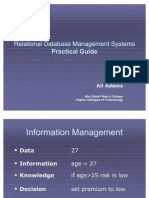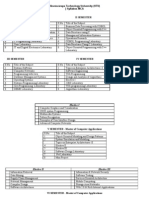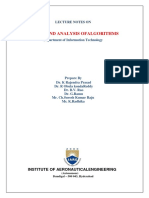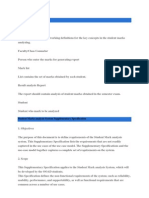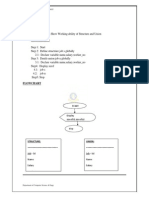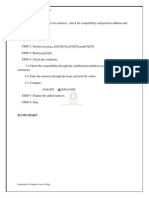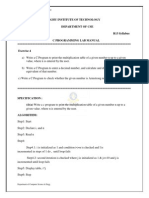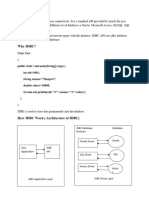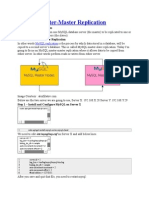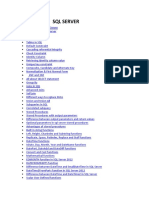DBMS Lab Manual
DBMS Lab Manual
Uploaded by
prasad9440024661Copyright:
Available Formats
DBMS Lab Manual
DBMS Lab Manual
Uploaded by
prasad9440024661Copyright
Available Formats
Share this document
Did you find this document useful?
Is this content inappropriate?
Copyright:
Available Formats
DBMS Lab Manual
DBMS Lab Manual
Uploaded by
prasad9440024661Copyright:
Available Formats
Data Base Management Systems
Lab Manual for III B.Tech II Semester CSE
Prepared By
Sri V Prasad
Associate Professor
Dept. Of Computer Science & Engg.
Raghu Institute of Technology
Approved by AICTE(New Delhi) , Affiliated to Andhra University(Andhra Pradesh),
Dakamarri(V), Bheemunipatnam (M), Visakhapatnam District, Andhra Pradesh, India.
Tel No: +91 8922 248003, 248013. Fax no: +91 8922 248013. Website: www.raghuinstech.com
DBMS Lab Manual for III B.Tech II Sem CSE & IT
Raghu Institute Of Technology
S.No
Content
Lab Objective
Introduction to DBMS
(a) Introduction to Oracle 10 G Express.
(b) Installation Screens of Oracle 10G
Introduction to SQL
List of Syllabus Programs
Project -1
Abstract Class Marks Management System
6
Introduction to Class Marks Management Systems
(a) DDL & DML Statements(Table Creations for CMM)
(b) Importance of Dual Command
(c) Queries and Sub Queries Generation Using
7
(i)
(ii)
(iii)
(iv)
(v)
Relational functions
Aggregate Functions
Conversion Functions
String Functions
Date Functions
VIEWS (a)Creation (b) Updating (c) Deletion .
PL /SQL Programming with Exception Handling
10
Functions Implementation
11
Procedure Implementation
12
Trigger Generations on Active Tables
Page No.
DBMS Lab Manual for III B.Tech II Sem CSE & IT
INDEX
13
Raghu Institute Of Technology
E-R Diagrams for CMM
Project -2
13
Viva Voice Questions
14
Reference Books
DBMS Lab Manual for III B.Tech II Sem CSE & IT
Raghu Institute Of Technology
Lab Objective
Upon completing the course, students will be fully prepared to design, implement and manage DBMS to serve a wide range
of goals in a range of educational settings.
Students will specifically be able to do the following:
Describe the uses of DBMS within educational settings.
Describe the benefits and structure of a relational DBMS.
Understand basic concepts and terminology related to DBMS.
Know and use procedures to design and implement a basic DBMS.
Implement the rules of data normalization to improve DBMS design.
Build tables and construct relationships among them utilizing normalized data.
Retrieve data with simple queries.
Design and implement a simple DBMS to integrate into a classroom lesson.
Design, create and use forms for data entry.
Define and use queries to access specific data.
Create a lesson plan that includes an existing database in an integral way.
Design and implement a base DBMS to integrate into a specific classroom instructional situation.
Know advanced DBMS topics and techniques regarding design, data and tables, queries, forms and reports.
Analyze an educational situation to identify data components and relationship among them.
Use a student achievement DBMS to guide instructional decisions for classrooms, schools, and districts.
Discuss a variety of current issues related to using DBMS in educational settings.
Understand a variety of currently emerging developments and trends related to DBMS.
Select among DBMS products in terms of tradeoffs between flexibility, performance, easy of use and cost.
DBMS Lab Manual for III B.Tech II Sem CSE & IT
Raghu Institute Of Technology
LIST OF PROJECTS TO BE CONDUCTED IN THE LAB
CSE 3.2.8 DBMS LAB Credits:2
Univ-Exam : 3 Hours
Lab: 3 Periods/week Sessional Marks: 50
Univ-Exam-Marks: 50
Study features of a commercial RDBMS package such as ORACLE/DB2, MS Access, MYSQL & Structured
Query Language (SQL) used with the RDBMS.( Select two of RDMSs)
Laboratory exercises should include defining schemas for applications, creation of a database,
writing SQL queries, to retrieve information from the database, use of host languages,
interface with the embedded SQL, use of forms & report writing packages available with the chosen
RDBMS product.
Some sample applications, which may be programmed, are given below:
1. Class marks management.
2. Accounting package for a shop.
3. Database manager for a Magazine agency or a newspaper agency.
4. Ticket booking for performances.
5. Preparing greeting cards & birthday cards.
6. Personal accounts - Insurance, loans, mortgage payments, etc.
7. Doctor's diary& billing system.
8. Personal bank account.
9. Hostel accounting.
10. Video Tape library.
11. History of cricket scores.
12. Cable TV transmission program manager.
13. Personal library.
DBMS Lab Manual for III B.Tech II Sem CSE & IT
Raghu Institute Of Technology
INRODUCTION TO DATABASE MANAGEMENT SYSTEM.
A Database Management System (DBMS) is a set
of computer programs that controls the creation,
maintenance, and the use of a database. It allows
organizations to place control of database
development
in
the
hands
of database
administrators (DBAs) and other specialists. A DBMS
is a system software package that helps the use of
integrated collection of data records and files
known as databases. It allows different user
application programs to easily access the same
database. DBMSs may use any of a variety of
database
models,
such
as
the network
model or relational model. In large systems, a DBMS
allows users and other software to store and
retrieve data in a structured way. Instead of having
to write computer programs to extract information,
user can ask simple questions in a query language.
Thus, many DBMS packages provide Fourthgeneration programming language (4GLs) and other
application development features. It helps to specify
the logical organization for a database and access
and use the information within a database. It
provides facilities for controlling data access,
enforcing data integrity, managing concurrency, and
restoring the database from backups. A DBMS also
provides the ability to logically present database
information to users.
The various functions of DBMS are
1. Data Definition
2. Data manipulation
3. Data security and integrity
4. Data recovery and concurrency
5. Data dictionary maintaince
6. Performance
DBMS consists of
1. Data base design
2.
3.
4.
5.
6.
Application development
Data analysis
Concurrency and robustness
Efficiency
Security
We can hide the data in the
database. A DBMS is a set of software programs that
controls the organization, storage, management,
and retrieval of data in a database. We can hide the
data in the database.i.e the Data Abstraction. There
are certain levels in the data abstraction, they are
1. Physical level
2. Logical level
3. View level
The overall design of a database is called as
SCHEMA. There are 3 types of schemas. Physical
schema, logical schema, sub schema. The data in
the database is stored in the form of entities, the
tables. The content is in the form of bytes. We can
perform certain operations of DDL,DML commands
for the entities in the database like create ,insert,
delete, rename, alter, truncate, drop, update. A
VIEW is a table whose rows are not explicitly stored
in the database but are computed as needed,it can
be used just like a base table. We can perform
operations like create, update, delete, drop.
An entity-relationship model (ERM) is an
abstract and conceptual representation of data.
Entity-relationship modeling is a database modeling
method, used to produce a type of conceptual
schema or semantic data model of a system, often a
relational database, and its requirements in a topdown fashion. Diagrams created by this process are
called ER diagrams. We represent the relation
between the entites in the ER diagrams. We have
DBMS Lab Manual for III B.Tech II Sem CSE & IT
certain relations like Binary relation, Ternary
relation, and Aggregate relation. We have certain
Integrity constraints over the relationships.
We can remove the unwanted data in the
database,is NORMALIZATION, elimination of
redundant data. There are befinits of normalization
1. Less storage space
2. Quicker updates
3. Less data inconsistency
4. Easier to add data
5. Flexible structure
6. Clearer data relationships
We have types in normalization like
0NF,1NF,2NF,3NF,Boyce-codd normal form.
A trigger is a application which consists of
event ,condition, and action in an organized
manner. It will be activated only when there is some
insertion, deletion or modification of content
present in database. There are 2 types of triggers
row-level trigger and statement level trigger.
Raghu Institute Of Technology
Applications of DBMS
1. Data indepence
2. Efficient data access
3. Data integrity
4. Data security
5. Data admistration
6. Concurrent access
7. Crash recovery
8. Reduced application development
Examples of DBMS are:
1. Banking
2. Finance
3. Human resources
4. Tele communication
5. Universities
6. Airlines
7. Online ticket booking
8. In e-seva .
DBMS Lab Manual for III B.Tech II Sem CSE & IT
Raghu Institute Of Technology
INTRODUCTION TO ORACLE 10G
The Oracle Database (commonly referred to
as Oracle RDBMS or simply as Oracle) is an objectrelational database management system (ORDBMS)
produced and marketed by Oracle Corporation. An
oracle is free to develop, delay and distributed.
Oracle database 10g express edition is an entry
level, small foot print database based on the oracle
database 10g release to code base thats free to
develop, delay and distribute, fast to download and
simple to administer. Oracle database XE is a great
starter database for:
Developers working on PHP, JAVA, .NET,
XML and open source application.
DBAs who need a free starter database for
training and development.
Independent software vendors (ISVS) and
hardware vendors who want a starter
database to distribute free of charge.
Educational institutions and students who
need free database for their curriculum.
With oracle database XE,we can now develop and
delay application with a powerful, proven, industry
leading infrastructure and then upgrade when
necessary without costly and complex migrations.
An Oracle database systemidentified by an
alphanumeric system identifier or SID comprises at
least one instance of the application, along with
data storage. Users of the Oracle databases refer to
the server-side memory-structure as the SGA
(System Global Area). The Oracle DBMS can store
and execute stored procedures and functions within
itself. PL/SQL (Oracle Corporation's proprietary
procedural extension to SQL), or the object-oriented
language Java can invoke such code objects and/or
provide the programming structures for writing
them. The Oracle RDBMS stores data logically in the
form of table spaces and physically in the form of
data files ("data files").Table spaces can contain
various types of memory segments, such as Data
Segments, Index Segments, etc. Segments in turn
comprise one or more extents. Extents comprise
groups of contiguous data blocks. Data blocks from
the basic units of data storage.
Oracle database conventions refer to defined
groups of object ownership (generally associated
with a "username") as schemas. Each Oracle
instance uses a System Global Area or SGA a sharedmemory areato store its data and controlinformation. Each Oracle instance allocates itself an
SGA when it starts and de-allocates it at shut-down
time.
The library cache stores shared SQL, caching the
parse tree and the execution plan for every unique
SQL statement. If multiple applications issue the
same SQL statement, each application can access
the shared SQL area. This reduces the amount of
memory needed and reduces the processing-time
used for parsing and execution planning.
The data dictionary comprises a set of tables
and views that map the structure of the database.
Oracle databases store information here about the
logical and physical structure of the database. The
data dictionary contains information such as:
User information, such as user privileges
Integrity constraints defined for tables in the
database
Names and datatypes of all columns in database
tables
DBMS Lab Manual for III B.Tech II Sem CSE & IT
Information on space allocated and used for
schema objects.
The Program Global Area or PGA memory-area of an
Oracle instance contains data and controlinformation for Oracle's server-processes. The
dynamic performance views (also known as "fixed
views") within an Oracle database present
information from virtual tables (X$ tables) built on
the basis of database memory. Database users can
Raghu Institute Of Technology
Oracle Applications Release 11i (aka Oracle eBusiness Suite, Oracle Financials or Oracle 11i):
a suite of business applications;
Oracle Developer Suite 10g (9.0.4);
Oracle
JDeveloper 10g:
development environment;
a Java integrated
The latest certification information of oracle
application server log(10.1.4)
access the V$ views to obtain information on
database structures and performance.
Licensing information regarding compliance for
oracle application server is available at
Oracle database can be installed on any size host
http://www.oracle.com/technology/productias/
index.html.
machine with any number of cpus, but XE will store
upto 4GB of user data, use upto 16GB of memory
and use one cpu on the host machine.
Version numbering:
Oracle Application Server 10g (also known as
"Oracle AS 10g"): a middleware product;
DBMS Lab Manual for III B.Tech II Sem CSE & IT
ORACLE 10 G PRINT SCREENS
Raghu Institute Of Technology
DBMS Lab Manual for III B.Tech II Sem CSE & IT
Raghu Institute Of Technology
DBMS Lab Manual for III B.Tech II Sem CSE & IT
Raghu Institute Of Technology
DBMS Lab Manual for III B.Tech II Sem CSE & IT
Raghu Institute Of Technology
DBMS Lab Manual for III B.Tech II Sem CSE & IT
Raghu Institute Of Technology
DBMS Lab Manual for III B.Tech II Sem CSE & IT
Raghu Institute Of Technology
PROJECT TITLE : CLASS MARKS MANAGEMENT SYSTEM
ABSTRACT
The basic idea of generating this project is for showing the essentiality of ER Diagrams in the
Data base management systems. Organizing of the data according to the relevant information is
clearly specified in our project .
Class marks management system is an entity-relationship model based database
management project. We use Oracle 10g to implement this project. It has been designed to maintain
and manage the database of the marks and other information of the students in a class. In this
database we maintain the information of the students, the faculty who teach these students and the
subjects they handle along with the department information.
We create the entities- student, faculty, department, subject and marks. We establish
relationships between the entities such as assigns, learns, studies, handles and an aggregation
relationship-monitors. There are integrity constraints for every entity which makes the database more
flexible and data retrieval easy.
We normalize the data stored in the database so as to eliminate data duplication which can
further lead to the destruction of data integrity. The efficiency of the output has been improved by
imbibing various features into the program like nested-if, case and case expressions, cursors,
conversion functions, procedures and functions. We also use triggers to make our system more
responsive.
DBMS Lab Manual for III B.Tech II Sem CSE & IT
Raghu Institute Of Technology
INTRODUCTION TO CLASS MARKS MANAGEMENT SYSTEM
In the project, class marks management system, firstly we created an entity-relationship
diagram. According to the design created we listed the entities with their attributes as follows:
-Student entity: It has the attributes-sid (student id), sname (students name),saddr (students
address).
-Subject entity: It has
subauthor(books author name).
the
attributes-subid(subjects
id)
fname(facultys
name),
-Marks entity: It has the attributes-sid, subid and marks (marks of each student in each
subject).
-Faculty entity:It has the attributes-fid(facultys id), fname(faculty;s name), fsubject(subject
taught by that faculty).s
-Department entity: It has the attributes-did (departments id), dname(departments name),
dhod(departments head).
The relationships that we established between the above defined entities are:
-learns: This relationship is between the entities student and subject. It contains the
descriptive attribute since and derived attributes-sid, subfac.
-assigns: This relationship is between the entities faculty and marks. It has the derived
attributes-fid, sid, subid, smarks.
-handles: This relationship is between the entities department and faculty. It has the
descriptive attribute-since.
-studies: This relationship is between the student and department entities.
-monitors: This relationship is an aggregation relationship between the relationship set that
consists of faculty and department and the entity student.
We use various key constraints in these entities, such as:
-primary key: This key uniquely identifies a tuple. The primary keys used in the defined entities
are:->Sid in student entity
->subid in subject entity
DBMS Lab Manual for III B.Tech II Sem CSE & IT
Raghu Institute Of Technology
->fid in faculty entity
->did in department entity.
Here the entity marks doesnt have a primary key, it depends on another entity for a unique id,
and hence its a weak entity.
-foreign key: To keep the data consistent, we use an integrity constraint that involves relations,
linking them both. This is nothing but the foreign key. Some of the foreign keys used here are:
->sid is a foreign key in marks entity.
->subid is also a foreign key in marks entity.
SQL queries: They allow the user to describe desired data, leaving the database management system
(DBMS) responsible for planning, optimizing, and performing the physical operations necessary to
produce that result as it chooses. To enhance the efficiency of these queries we use:
-nested queries, in which a relation referred to in the query is itself defined within the query.
-aggregate operators, which allows us to write SQL queries that are not expressible in relational
algebra.
-cursors, using which relations can be accessed one tuple at a time.
-triggers are which describe actions to be taken when certain situations arise. These are invoked
when such situations arise.
-procedures and functions, are a set of statements that can be executed. A procedure doesnt
return a value, but a function does.
In this project, we also implemented views (a relation whose instance is not explicitly
stored but are computed as need) to enable logical independence.
PL/SQL programs have been written using many enhanced features of SQL, to improve the
efficiency of programming, like:
-nested-if.
-case and case expressions.
-nullif functions etc.
Conversion functions for string manipulation and date format conversions have also been
implemented.
DBMS Lab Manual for III B.Tech II Sem CSE & IT
Raghu Institute Of Technology
Oracle exe 10g -- Oracle Database 10G Express Edition
Modes for Executing
1. Graphical Mode(Goto Home Page)
2. Command Mode(Run SQL Command Line)
Administrator User : system
Password : Userdefined
Path where the programs will be stored defaultly: C:\oraclexe\app\oracle\product\10.2.0\server\BIN
DDL Statements:
Creation Of Tables with & Without Constraints :
create table student
(sid NUMBER NOT NULL PRIMARY
KEY,
roll NUMBER NOT NULL PRIMARY
KEY,
name varchar(10) NOT NULL,
age NUMBER NOT NULL);
SID
CREATE TABLE Department
(deptno NUMBER PRIMARY KEY,
deptname VARCHAR2(20));
ROLL
NAME
DEPTNO
CREATE TABLE Employee
(empno NUMBER PRIMARY KEY,
empname VARCHAR2(20),
deptno NUMBER REFERENCES
Department(deptno));
DEPTNAME
EMPNO
CREATE TABLE student( roll NUMBER PRIMARY KEY,
name VARCHAR2(10) NOT NULL,
marks NUMBER NOT NULL CHECK
AGE
EMPNAME
SID
ROLL
DEPTNO
MARKS
( marks BETWEEN 50 AND 99));
ALTER WITH ADD:
alter table student add address varchar(10);
SID
ROLL
NAME
AGE
ADDRESS
DBMS Lab Manual for III B.Tech II Sem CSE & IT
Raghu Institute Of Technology
ALTER with MODIFY:
alter table student MODIFY address VARCHAR2 (20);
/* The Byte Size of Address has been changed */
DROP:
drop table student;
/* Drops the Table Student */
RENAME :
rename student to student1;
Name */
/* Renames Student Table with Student 1
TRUNCATE :
Truncate student;
Removed*/
/* Data in the Students table is
To Run Programming files in Command Mode:
EDIT xyz.txt
SQL> @ filename
or
SQL> @ path\filename
ROLL
NAME
yash
raj
Save xyz.txt
Srinu
To get the Command Back , Just Type
Lakhan
2 RUN
2 RUN
Enter the Data in a file as:
Select roll,name from student;
Get xyz.txt
DML Statements :
insert into student values(1001,1,'raj',78);
insert into student values(1002,2,'Yash',67);
insert into student values(1003,3,'Srinu',84);
insert into student values(1004,4,'Lakhan',97);
Inserting Values at the run time :
SID
ROLL
NAME
MARKS
1002
yash
20
1001
raj
19
1003
Srinu
22
1004
Lakhan
23
DBMS Lab Manual for III B.Tech II Sem CSE & IT
Raghu Institute Of Technology
INSERT INTO student VALUES (&sid,&roll, &name, &marks);
Sorting in form of marks :
SID
ROLL
NAME
AGE
select * from student order by age;
1002
Yash
19
1001
Raj
20
1003
Srinu
22
1004
Lakhan
23
Update with Set using where clause:
UPDATE student SET name = 'raju' WHERE roll = 2;
/* Changing name of Yash to Raju */
DELETE using where clause:
DELETE FROM mrk WHERE reg = 2; /* Delete a tupple whose reg equals 2*/
Get List Of Tables :
Select * from tab ;
/* To see the list of tables in the database*/
To Get Structure Of Table:
DESCRIBE student;
To Quit : EXIT
/* Description of the table is given*/
/* To Quit from Data Base */
DUAL
Its a Single column /single table to evaluate constant expression in a select statement. (Contains
Dummy Value)
select * from dual;
Output : X
select sysdate from dual;
Output: System Date is Displayed
select 2+3 from dual;
Output : 5
SELECT TO_DATE ('2-1-09', 'mm-dd-yy') FROM DUAL;
To current Date:
Output: Day is Displayed
DBMS Lab Manual for III B.Tech II Sem CSE & IT
Raghu Institute Of Technology
SELECT TO_CHAR (sysdate, 'mm-dd-yy') FROM DUAL;
Queries (along with sub Queries) using ANY, ALL, IN, EXISTS, NOTEXISTS, UNION, INTERSECT,
Constraints.
Create the table marks(roll number,name
char(20),marks number);
ROLL
NAME
MARKS
Insert into marks values(1,raj,93);
Insert into marks values(2,yash,78);
Insert into marks values(3,srinu,89);
Insert into marks values(4,lakhan,68);
ROLL
1
2
3
4
NAME
Raj
Yash
Srinu
Lakhan
MARKS
93
78
89
68
ANY:
select * from marks where marks = ANY (89,
78);
Output -
ROLL
2
3
NAME
Yash
Srinu
MARKS
78
89
ROLL
1
4
NAME
Raj
Lakhan
MARKS
93
68
ROLL
2
NAME
Yash
MARKS
78
ALL:
select * from marks where roll <> ALL (2, 3);
Output -
UNION :
select * from marks where marks <80 union
select * from marks where marks > 70;
Output -
INTERSECT:
select * from marks where marks <80 intersect
select * from marks where marks > 50;
Output is: roll 5,6
ORDER BY & DESC:
select * from marks ORDER BY marks DESC;
Output-
ROLL
NAME
MARKS
Raj
93
Srinu
89
Yash
78
Lakhan
68
DBMS Lab Manual for III B.Tech II Sem CSE & IT
Raghu Institute Of Technology
SUB-QUERIES:
Output Select * from (select * from marks ORDER BY marks DESC)
where rownum < 3;
ROLL
NAME
1
Raj
3
Srinu
IN:
select * FROM marks where roll IN (3,4);
Output ROLL
3
4
NOT IN:
select * FROM marks where roll NOT IN
(2,3,4);
ROLL
1
MARKS
89
68
NAME
Raj
MARKS
93
NAME
Raj
MARKS
93
OutputROLL
1
EXISTS:
select * FROM marks where EXISTS
(select marks FROM marks where marks = 68);
NAME
Srinu
Lakhan
Output-
SELECTION :
select marks FROM marks where marks = 93;
MARKS
93
89
OutputROLL
4
NAME
Lakhan
MARKS
68
NOT EXISTS:
select * FROM marks where NOT EXISTS (select marks FROM marks where marks = 93);
Output : No Data will be available
Aggregate functions
(COUNT, SUM, AVG, MAX and MIN), GROUP BY,
HAVING .
COUNT:
select COUNT (marks) FROM marks;
Output - 4
select COUNT (marks) FROM marks where marks
>70;
Output -3
SUM:
select SUM (marks) FROM marks;
Output -328
select SUM (marks) FROM marks where marks>70;
Output -260
AVG:
select AVG (marks) FROM marks;
Output is : 82.0
select AVG (marks) FROM marks where marks>90;
DBMS Lab Manual for III B.Tech II Sem CSE & IT
Output is: 93
MAX:
select MAX(marks) from marks;
Output is : 93
MIN:
select MIN(marks) from marks;
Output is: 68
select MAX (marks), MIN (marks) FROM marks;
Output is : 93 & 68
GROUP BY:
The GROUP BY clause can be used to summarize
rows into a group or groups of rows based on a
grouping function placed into the select clause.
HAVING:
The HAVING clause can then be used to filter out
unwanted groups much like the where clause.
The expression for the select statement must
include at least one grouping function such as MAX()
or COUNT().
You use the GROUP BY clause to group rows into
blocks with a common column value
GROUP BY:
Select sdept, max(sbudget) from student3 group by
sdept;
Output is : Dpet name with Highest Budget each
Raghu Institute Of Technology
string functions (Concatenation, lpad, rpad, ltrim,
rtrim, lower, upper, initcap, length, substr and
instr),
SELECT RPAD(roll, 12, '.'), LPAD(marks, 2, '*') FROM
marks WHERE rownum < 3;
SELECT UPPER(name), INITCAP(name) FROM marks
ORDER BY LENGTH(name);
Select LTRIM ('** Prasad ** ', '*') FROM dual;
select RTRIM (' ** Prasad is Great **', '*') FROM
dual;
select TRIM (both '*' from '** Prasad **') FROM
dual;
select SUBSTR(Prasad',2) "sub1" from dual ;
select SUBSTR( 'Prasadisgreat', 4, 3) "sub2" from
dual;
select INSTR ( 'Prasad', 'd' ) "position1" from dual;
select INSTR('Prasad is dangerous person','d',1,2)
"position2" from dual;
date functions (sysdate, next_day, add_months,
last_day, months_between)
SELECT SYSDATE FROM DUAL;
HAVING:
select sdept,count(sname) from student3 group by
sdept having count(sname)>2;
Output : ECE with 3
SELECT NEXT_DAY ('14-JAN-2010', 'WED') FROM
DUAL;
Conversion Functions
SELECT MONTHS_BETWEEN ('14-NOV-2009', '14DEC-2010') FROM DUAL;
String Functions
Date Functions
To char . To Date Functions
Least , Great ,Truncate & Round Functions
SELECT LAST_DAY ('17-JULY-2010') FROM DUAL;
to char, to date
SELECT TO_DATE ('2-1-10', 'mm-dd-yy') FROM
DUAL;
DBMS Lab Manual for III B.Tech II Sem CSE & IT
Raghu Institute Of Technology
SELECT TO_CHAR (sysdate, 'mm-dd-yy') FROM
DUAL;
SELECT ROUND (10.567, 2), TRUNC (10.567, 2)
FROM DUAL;
SELECT GREATEST(10, 20, 30), LEAST (10, 20, 30)
FROM DUAL;
least, greatest, trunc, round
Creating , Working & Deleting a View :
The result of a query is always a table, or more precisely, a derived table. Compared with real tables in the
database, the result of a query is volatile, but nevertheless, the result is a table. The only thing that is missing for
the query result is a name. Essentially, a view is just a query result with a given name. Retrieving information
from a view is done in the same manner as retrieving from a table: you simply include the view in the FROM
clause of a query. With some views you can also perform DML operations on the base tables. Views dont store
rows. Rows are always stored in tables.
Creating a View:
create view vmarks as select * from marks;
Output: View Created
Working on a View:
Check output for Vmarks
Select * from vmarks;
Dropping a View:
DROP VIEW vmarks;
View Dropped
Describe Command:
Desc marks;
ROLL
1
3
2
4
NAME
Raj
Srinu
Yash
Lakhan
MARKS
93
89
78
68
Distinct Command :
All Varieties of Categories can be seen
select distinct name from marks ;
DBMS Lab Manual for III B.Tech II Sem CSE & IT
Raghu Institute Of Technology
PL / SQL Programming
PL/SQL stands for Procedural Language Extension to SQL.
PL/SQL contains both SQL statements and standard programming constructs like variable declarations,
assignments, FOR, WHILE, IF, CASE and so on.
Program 1: General Pl/SQL Program
DECLARE
Cmarks NUMBER;
Creg NUMBER;
BEGIN
SELECT marks,reg into cmarks,creg from student WHERE reg=®
DBMS_OUTPUT.LINE_LINE (----------------------------);
DBMS_OUTPUT.LINE_LINE(the given number||creg||got||cmarks|| );
EXCEPTION
WHEN no_data_found THEN
DBMS_OUTPUT.PUT_LINE(no such reg number);
END;
OutputEnter value for reg:5
Old 6: where reg>®
New 6 : where reg=5;
The given number 5 got 90
Program 2: CURSOR REPRESENTATION
DECLARE
Cmark mrk%rowtype;
Cursor xyz is
SELECT * from mark where marks>&marks;
BEGIN
Open xyz;
LOOP
Exit WHEN xyz%notfound;
Fetch xyz into cmark;
DBMS_OUTPUT.PUT_LINE(CMARK.REG||||CMARK.NAME||||CMARK.MARK);
END LOOP;
END;
Output- Enter value for marks:85
Old 4: where mark>&mark;
New 4: where mark>85;
5
90 gyan
DBMS Lab Manual for III B.Tech II Sem CSE & IT
7
11
17
18
96
96
88
94
anita
ann
suleiman
salman
Program 3: EXCEPTION HANDLING
DECLARE
CURSOR xyz is
SELECT * from mark WHERE mark>&mark;
Vrxyz xyz%rowtype;
excp EXCEPTION;
BEGIN
OPEN xyz;
FETCH xyz into vrxyz;
If xyz%notfound THEN
RAISE excp;
END if;
CLOSE xyz;
For K in xyz
LOOP
DBMS_OUTPUT.LINE_LINE(K.reg||||K.mark|| ||K.name);
END LOOP;
EXCEPTION
WHEN excp THEN
DBMS_OUTPUT.LINE_LINE(NO DATA );
END;
Output- Enter value for marks-85
Old 3: where mark>&mark;
New 3: where mark>85;
5 90 gyan
7 96 anita
11 96 ann
17 88 suleiman
18 94 salman
Program 4: ELSE IF STATEMENT UTILIZATION
DECLARE
vmarks NUMBER ;
grade char(1);
BEGIN
SELECT marks
Raghu Institute Of Technology
DBMS Lab Manual for III B.Tech II Sem CSE & IT
INTO vmarks
FROM mrk
WHERE reg = ®
if vmarks >= 90 THEN grade := 'A' ;
elsif
vmarks >= 80 THEN grade := 'B' ;
elsif
vmarks >= 70 THEN grade := 'C' ;
elsif
vmarks >= 60 THEN grade := 'D' ;
ELSE grade := 'F';
END if;
DBMS_OUTPUT.PUT_LINE ('------------ ');
DBMS_OUTPUT.PUT_LINE (' grade is: '||grade);
END;
OutputEnter value for reg:18
Old 8: select marks into vmarks FROM mrk WHERE reg=®
new 8: select marks into vmarks FROM mrk WHERE reg=18;
Grade is :A
PL/SQL Procedure successfully completed.
Program 5: CASE STATEMENT
DECLARE
vmarks NUMBER ;
grade char(1);
BEGIN
SELECT marks
INTO vmarks
FROM mrk
WHERE reg = ®
CASE
WHEN vmarks >= 90 THEN grade := 'A' ;
WHEN vmarks >= 80 THEN grade := 'B' ;
WHEN vmarks >= 70 THEN grade := 'C' ;
WHEN vmarks >= 60 THEN grade := 'D' ;
ELSE grade := 'F';
Raghu Institute Of Technology
DBMS Lab Manual for III B.Tech II Sem CSE & IT
END CASE;
DBMS_OUTPUT.PUT_LINE ('------------ ');
DBMS_OUTPUT.PUT_LINE (' grade is: '||grade);
END;
OutputEnter value for reg:5
Old 8: select marks into vmarks FROM mrk WHERE reg=®
new 8: select marks into vmarks FROM mrk WHERE reg=5;
Grade is :A
PL/SQL Procedure successfully completed.
Program 6: CASE EXPRESSION STATEMENT
DECLARE
vmarks NUMBER ;
grade char(1);
BEGIN
SELECT marks
INTO vmarks
FROM mrk
WHERE reg = ®
grade :=
CASE
WHEN vmarks >= 90 THEN 'A'
WHEN vmarks >= 80 THEN 'B'
WHEN vmarks >= 70 THEN 'C'
WHEN vmarks >= 60 THEN 'D'
ELSE 'F'
END ;
DBMS_OUTPUT.PUT_LINE ('------------ ');
DBMS_OUTPUT.PUT_LINE (' grade is: '||grade);
END;
OutputEnter value for reg: 17
Old 8: select marks into vmarks FROM mrk WHERE reg=®
new 8: select marks into vmarks FROM mrk WHERE reg=17;
Grade is: B
Raghu Institute Of Technology
DBMS Lab Manual for III B.Tech II Sem CSE & IT
Raghu Institute Of Technology
PL/SQL Procedure successfully completed.
THE NULLIF FUNCTION
The NULLIF function compares two expressions. If they are equal, the function returns NULL; otherwise, it
returns the value of the first expression.
NULLIF has the following structure:
NULLIF (expression1, expression2)
The NULLIF function is equivalent to the following CASE expression:
CASE
WHEN expression1 = expression2 THEN NULL
ELSE expression1
END
Program 8: NULLIF
DECLARE
n NUMBER := &sn;
vremainder NUMBER;
BEGIN
-- calculate the remainder and if it is zero return a NULL
vremainder := NULLIF(MOD(n,2),0);
DBMS_OUTPUT.PUT_LINE ('v remainder: '||vremainder);
END;
OutputEnter value for sn:43
Old2: n number=&sn;
New2: n number=43;
Vremainder=1
DBMS Lab Manual for III B.Tech II Sem CSE & IT
Raghu Institute Of Technology
FUNCTIONS
A function is similar to a procedure except that a function must return a value.
CREATE OR REPLACE FUNCTION ptr
RETURN NUMBER AS
x NUMBER;
BEGIN
x := 1000;
RETURN x;
END ptr;
Output- SQL>@ptr
5/
Function Created
SQL>BEGIN
2 DBMS_OUTPUT.PUT_LINE
3 END;
4/
Ptr 1000
PL/SQL Procedure successfully completed.
create or replace function area(radius in number) return number as
v_pi number:=3.14;
v_area number;
begin
v_area:=v_pi*power(radius,2);
return v_area;
end area;
Output- SQL>@area
6/
Function Created
SQL>select area(10) from dual;
Area(10)
314
DBMS Lab Manual for III B.Tech II Sem CSE & IT
Raghu Institute Of Technology
PROCEDURES
Program for Representing a procedure without parameters:
Create or replace procedure PR1 as
Begin
DBMS_OUTPUT.PUT_LINE(Hai);
END;
Output- SQL>@PR1
3/
Procedure created
SQL>Execute PR1
Hai
PL/SQL Procedure successfully completed.
Program for Representing a procedure with parameters:
Create or replace procedure PR2(N1 IN Number, N2 IN Number, TOT OUT NUMBER) is
Begin
Tot:=n1+n2;
End;
Output- SQL>@PR2
4/
Procedure Created
SQL>Variable t number;
SQL>Exec PR2(100,200,:T)
PL/SQL Procedure successfully completed.
PRINT T
300
DBMS Lab Manual for III B.Tech II Sem CSE & IT
Raghu Institute Of Technology
TRIGGERS
Triggers are similar to procedures or functions in that they are named PL/SQL blocks with declarative,
executable, and exception handling sections.
Triggers must be stored as stand-alone objects in the database.
A trigger is executed implicitly whenever the triggering event happens, and a trigger doesnt accept arguments.
The act of executing a trigger is known as firing the trigger. The triggering event can be a
DML (INSERT, UPDATE, or DELETE) operation
On a database table or Certain kinds of views or a system event, such as database startup or shutdown
CREATE OR REPLACE TRIGGER trigmrk
AFTER UPDATE OF marks ON mrk
FOR EACH ROW
WHEN (OLD.marks != NEW.marks)
BEGIN
DBMS_OUTPUT.PUT_LINE('marks '
||:OLD.marks
||' have been change to '
||:NEW.marks);
END;
SET SERVEROUTPUT ON
UPDATE mrk
SET marks = 0
WHERE reg = ®
OUTPUT:
Old Marks 20 are changed to New Marks 50.
A Small Alert is Given when the Updation in the Table is given
DBMS Lab Manual for III B.Tech II Sem CSE & IT
Raghu Institute Of Technology
E-R Diagram Class Marks Management System
Buy SmartDraw!- purchased copies print this
document without a watermark .
Visit www.smartdraw.com or call 1-800-768-3729.
DBMS Lab Manual for III B.Tech II Sem CSE & IT
Raghu Institute Of Technology
DATA UPDATION & RETRIEVING DOCUMENT
MAKING ORACLE 10 G as a Back End & JSP as Front End.
Step 1: Installation of JDK: Don't forget to install JDK on your system (if not installed) because any tomcat requires the
Java 1.5 (Java 5) and Java 1.6 (Java 6) and then set the class path (environment variable) of JDK.
Step 2: Setting the class path variable is:
First right click on the My Computer->properties->advance->Environment Variables->path.
Set bin directory path of JDK in the path variable.
Step 3: Installation Of Tomcat Web Sever :
Install Tomcat 6.0 in JAVA Folder which is present in C:\Program Files\Java
DBMS Lab Manual for III B.Tech II Sem CSE & IT
Raghu Institute Of Technology
DBMS Lab Manual for III B.Tech II Sem CSE & IT
Raghu Institute Of Technology
DBMS Lab Manual for III B.Tech II Sem CSE & IT
Raghu Institute Of Technology
DBMS Lab Manual for III B.Tech II Sem CSE & IT
To
Raghu Institute Of Technology
DBMS Lab Manual for III B.Tech II Sem CSE & IT
Raghu Institute Of Technology
If installation process completes successfully then a window as shown below will appear.
DBMS Lab Manual for III B.Tech II Sem CSE & IT
Raghu Institute Of Technology
Step 4: Add a Jar File Called ojdbc14.jar into the C:\Program Files\Java\Tomcat 6.0\lib
Then Once again restart your tomcat webserver and check whether the Server Responding properly or not.
Step 5: Place All yout JSP files in the folder C:\Program Files\Java\Tomcat 6.0\webapps by creating a New
Folder
Into the New Folder copy the Content i.e., META-INF Files and images files and index.html and index.jsp files into your
New Folder Which is Created
Step 6: Then Start Executing ur program in the browser by http://localhost:8080/it/reg.jsp
Program 1: Program For Entering Data into the Data Base :
/*.Update.jsp.*/
<%@ page contentType="text/html; charset=iso-8859-1" language="java" import="java.sql.*" errorPage="" %>
<!DOCTYPE HTML PUBLIC "-//W3C//DTD HTML 4.01 Transitional//EN"
"http://www.w3.org/TR/html4/loose.dtd"
<HTML>
<script type="text/javascript" src="JScript/script.js"></script>
<body id="reg">
<FORM name="form">
<h1><center> DBMS Lab -- Importance of Data Base as Back Ground </center> </h1><br><br><br>
<table align="center" border="2">
<tr>
<td>Name Of the Candidate :</td>
<TD><INPUT TYPE="text" name="name" class="reqd name"></td> </tr> <tr>
<td>Password Chosen :</td>
<td> <INPUT TYPE="PASSWORD" name="passwd" class="reqd passwd"> </td></tr>
<tr><td>Email ID:</td>
<td> <INPUT TYPE="TEXT" name="EMAIL" class="reqd email"> </td> </tr></tr>
<td>Phone Number :</td>
<td><INPUT TYPE="TEXT" name="PNO" class="reqd pno"> </td></tr>
<tr>
<td align="right"><input type="submit" id="submit"></td>
<td align="center"><input type="reset"></td>
</tr>
</table>
</FORM>
<%
String name = request.getParameter("name");
String pass = request.getParameter("passwd");
String email = request.getParameter("EMAIL");
String pno = request.getParameter("PNO");
/* Create string of connection url within specified format with machine name, port number and database name. Here
machine name id localhost and database name is logindata. */
String connectionURL = "jdbc:oracle:thin:@127.0.0.1:1521:XE";
// declare a connection by using Connection interface
Connection connection = null;
// declare object of Statement interface that uses for
PreparedStatement pstatement = null;
DBMS Lab Manual for III B.Tech II Sem CSE & IT
// Load JDBC driver "oracle.jdbc.OracleDriver"
Class.forName("oracle.jdbc.OracleDriver").newInstance();
int updateQuery = 0;
// check if the text box is empty
if(email!=null && pass!=null && pno!=null && name!=null){
// check if the text box having only blank spaces
if(email!="" && pass!="" && pno!="" && name!="") {
try {
/* Create a connection by using getConnection()
method that takes parameters of string type
connection url, user name and password to connect
to database. */
connection = DriverManager.getConnection
(connectionURL, "system", "oracle");
// sql query to insert values in the secified table.
String queryString = "INSERT INTO reg values(?,?,?,?)";
/* createStatement() is used for create statement
object that is used for
sending sql statements to the specified database. */
pstatement = connection.prepareStatement(queryString);
pstatement.setString(1, name);
pstatement.setString(2, pass);
pstatement.setString(3, email);
pstatement.setString(4, pno);
updateQuery = pstatement.executeUpdate();
if (updateQuery != 0) { %>
<script type="text/javascript">
alert("Data Entered Successfully");
</script>
<%
}
}
catch (Exception ex) { %>
<script type="text/javascript">
alert("invalid");
</script>
<%
}
finally {
// close all the connections.
pstatement.close();
connection.close();
}
}
}
%>
</body>
</html>
Raghu Institute Of Technology
DBMS Lab Manual for III B.Tech II Sem CSE & IT
Output Screens :
Raghu Institute Of Technology
DBMS Lab Manual for III B.Tech II Sem CSE & IT
Raghu Institute Of Technology
DBMS Lab Manual for III B.Tech II Sem CSE & IT
Program 2: Program for Retrieving the Data From the Data Base :
/*.display.jsp.*/
<%@ page import="java.sql.*" %>
<% Class.forName("sun.jdbc.odbc.JdbcOdbcDriver"); %>
<HTML>
<HEAD>
<TITLE>Retrieving the Data From the Data Base </TITLE>
</HEAD>
<BODY>
<H1><center> Retrieving the Data Fro the Data Base <center > </H1>
<%
Connection connection = DriverManager.getConnection
("jdbc:oracle:thin:@127.0.0.1:1521:XE", "system", "oracle");
Statement statement = connection.createStatement() ;
ResultSet resultset =
statement.executeQuery("select * from reg11") ;
%>
<br><br>
<TABLE BORDER="1" align="center">
<TR>
<TH>Name </TH>
<TH>Address</TH>
<TH>Country</TH>
<TH>Hobbies</TH>
</TR>
<% while(resultset.next()){ %>
Raghu Institute Of Technology
DBMS Lab Manual for III B.Tech II Sem CSE & IT
<TR>
<TD> <%= resultset.getString(1) %></td>
<TD> <%= resultset.getString(2) %></TD>
<TD> <%= resultset.getString(3) %></TD>
<TD> <%= resultset.getString(4) %></TD>
</TR>
<% } %>
</TABLE>
</BODY>
</HTML>
Output Screens :
Raghu Institute Of Technology
DBMS Lab Manual for III B.Tech II Sem CSE & IT
Raghu Institute Of Technology
Viva Voice Questions ?
1.What is a Database?
2.What is DBMS?
3.Explain Data Base System?
4.Trace the Advantages in DBMS ?
5.List the disadvantages in DBMS?
6.Describe the three levels of data abstraction?
7.Define the "integrity rules".
8.What is Data Independence?
9.What is a view? How it is related to data
independence?
10.What is Data Model?
11.What is E-R model?
12.What is Object Oriented model?
13. What is an Entity?
14.What is an Entity type?
15. What is an Entity set?
16.What is an Extension of entity type?
17.What is Weak Entity set?
18.What is an attribute?
19.What is a Relation Schema and a Relation?
20. What is degree of a Relation?
21. What is Relationship?
22. What is Relationship set?
23. What is Relationship type?
24. What is degree of Relationship type?
25. What is DDL (Data Definition Language)?
26. What is VDL (View Definition Language)?
27. What is SDL (Storage Definition Language)?
28. What is Data Storage - Definition Language?
29. What is DML (Data Manipulation Language)?
30. What is DML Compiler?
31. What is Query evaluation engine?
32. What is DDL Interpreter?
33. What is Relational Algebra?
34. What is Relational Calculus?
35. How does Tuple-oriented relational calculus
differ from domain-oriented relational
calculus
36. What is normalization?
37. What is Functional Dependency?
38. When is a functional dependency F said to be
minimal?
39. What is Multivalued dependency?
40. What is Lossless join property?
41. What is 1 NF (Normal Form)?
42. What is Fully Functional dependency?
43. What is 2NF?
44. What is 3NF?
45. What is BCNF (Boyce-Codd Normal Form)?.
46. What are partial, alternate,, artificial, compound
and natural key?
47. What is indexing and what are the different
kinds of indexing?
48. What is system catalog or catalog relation? How
is better known as?
49. What is meant by query optimization?
50. What is durability in DBMS?
51. What do you mean by atomicity and
aggregation?
52. What is a Phantom Deadlock?
53. What is a checkpoint and When does it occur?
54. What are the different phases of transaction?
55. What do you mean by flat file database?
56. What is "transparent DBMS"?
57. What is a query?
58. What do you mean by Correlated subquery?
59. What is a Tigger
60.What is an active database
61. Define a function
62. How procedure helps us in PL SQL Programming
DBMS Lab Manual for III B.Tech II Sem CSE & IT
Raghu Institute Of Technology
References:
Database Management Systems by Raghu Ramakrishnan and Johannes Gehrke, McGraw-Hill
ORACLE PL/SQL by example. Benjamin Rosenzweig, Elena Silvestrova, Pearson Education 3 rd Edition
ORACLE DATA BASE 1OG PL/SQL Programming SCOTT URMAN, Tata Mc-Graw Hill.
SQL & PL/SQL for Oracle 10g, Black Book, Dr.P.S. Deshpande.
You might also like
- App Builder - Project 2 - Requirement PDFDocument2 pagesApp Builder - Project 2 - Requirement PDFPrince Manocha0% (1)
- DB2 DBA SyllabusDocument9 pagesDB2 DBA SyllabussumanthvmNo ratings yet
- DbmsDocument2 pagesDbmsAdio odunolaNo ratings yet
- DBA Solved AllDocument22 pagesDBA Solved AllSaad Mansoor57% (7)
- Aspnet The Complete Reference by Matthew Macdonald Robert Standefer 0072195134 PDFDocument5 pagesAspnet The Complete Reference by Matthew Macdonald Robert Standefer 0072195134 PDFShubham DeshpandeNo ratings yet
- TAFJ-DB Performance PDFDocument19 pagesTAFJ-DB Performance PDFDevinda De Zoysa100% (1)
- Module 1 - Lab Exercise On JDBC: Name Year SubjectDocument2 pagesModule 1 - Lab Exercise On JDBC: Name Year Subjectkalaamani c1400100% (1)
- RDBMS SeminarDocument70 pagesRDBMS SeminarSohoo Abdul QayoomNo ratings yet
- Experiment No.02: LAB Manual Part ADocument10 pagesExperiment No.02: LAB Manual Part AShubham GuptaNo ratings yet
- DBMS Lab Manual Jan2024 PDFDocument80 pagesDBMS Lab Manual Jan2024 PDFKamal MNo ratings yet
- Unit 5 - Object Relational and No-SQL Databases v1 1Document83 pagesUnit 5 - Object Relational and No-SQL Databases v1 1Aishwarya GiridevNo ratings yet
- Final DBMS ManualDocument92 pagesFinal DBMS ManualThe ultimate MathsNo ratings yet
- DBMS Chapter 2 - Data ModelsDocument60 pagesDBMS Chapter 2 - Data ModelsJM RosaldesNo ratings yet
- IntroductionDocument25 pagesIntroductionN Latha ReddyNo ratings yet
- CS8651 - IP - Notes - Unit 4Document90 pagesCS8651 - IP - Notes - Unit 4J. MEENANo ratings yet
- WEEK 4 - What Is Common Table ExpressionsDocument3 pagesWEEK 4 - What Is Common Table ExpressionsAngelique Garrido VNo ratings yet
- Unit-4 (OOAD)Document83 pagesUnit-4 (OOAD)karthikeyanbe44292% (12)
- Software Engineering & Project Management Lab Practical: B.Tech CSE IV SemDocument1 pageSoftware Engineering & Project Management Lab Practical: B.Tech CSE IV Semshubh agrawalNo ratings yet
- ADBMS Lab Manual Aug-Dec 2017 - ByMeDocument9 pagesADBMS Lab Manual Aug-Dec 2017 - ByMeDennise ShughniNo ratings yet
- Visvesvaraya Technology University (VTU) ) Syllabus-MCADocument3 pagesVisvesvaraya Technology University (VTU) ) Syllabus-MCAAngom Santu Meetei0% (1)
- Advanced Database Management System - Tutorials and Notes - Partitioned Parallel Hash JoinDocument6 pagesAdvanced Database Management System - Tutorials and Notes - Partitioned Parallel Hash JoinNadeem MujawarNo ratings yet
- Railway Reservation SystemDocument51 pagesRailway Reservation SystemVijendra SolankiNo ratings yet
- Job Recommender Java Spring BootDocument21 pagesJob Recommender Java Spring BootHanuman Sai MajetiNo ratings yet
- On MYSQL COMMANDSDocument9 pagesOn MYSQL COMMANDSAnonymous StudentNo ratings yet
- 16 MarksDocument3 pages16 MarksABIRAMINo ratings yet
- Core Java Assignments Lab 3Document11 pagesCore Java Assignments Lab 3Gurjar Devyani25% (4)
- Dbms Lab ManualDocument19 pagesDbms Lab ManualGurpreet SinghNo ratings yet
- ESDL Lab ManualDocument7 pagesESDL Lab Manualanbhute3484No ratings yet
- Daa Lecture NotesDocument120 pagesDaa Lecture NotesManoharNo ratings yet
- DHTML EventsDocument14 pagesDHTML EventsRitesh Kumar 75No ratings yet
- "Calculate Area of Any Type of Shape Using Abstract Class.": Sneha Ohol (17) Madhura PansareDocument11 pages"Calculate Area of Any Type of Shape Using Abstract Class.": Sneha Ohol (17) Madhura PansareshubhamNo ratings yet
- ERD Lab ManualDocument6 pagesERD Lab ManualDua Abu HamdiNo ratings yet
- Presentation On Industrial TrainingDocument13 pagesPresentation On Industrial TrainingShishir MishraNo ratings yet
- 279 - DBMS Complete1Document121 pages279 - DBMS Complete1Pratiksha BhosaleNo ratings yet
- SPPU Web Technology Lab Questions For EndSemDocument2 pagesSPPU Web Technology Lab Questions For EndSemAneerban ChowdhuryNo ratings yet
- Data Structures NotesDocument193 pagesData Structures NotesRuthvik RachaNo ratings yet
- Web Design MANUAL MergedDocument80 pagesWeb Design MANUAL MergedAslam NizamiNo ratings yet
- It8076 Software TestingDocument2 pagesIt8076 Software Testingdassdass22No ratings yet
- RDBMS LAB ManualDocument29 pagesRDBMS LAB ManualKetanPatelNo ratings yet
- Hbase Lab Manual3.0-UpdateDocument8 pagesHbase Lab Manual3.0-UpdateDムRK々 BLムDENo ratings yet
- TaxonomyDocument30 pagesTaxonomyAyush JhaNo ratings yet
- Difference Between MOLAP, ROLAP and HOLAP in SSASDocument3 pagesDifference Between MOLAP, ROLAP and HOLAP in SSASUmar AliNo ratings yet
- Chapter Five: Object-Oriented TestingDocument20 pagesChapter Five: Object-Oriented TestingMehari TemesgenNo ratings yet
- SQL - Interview QuestionDocument15 pagesSQL - Interview QuestionDeepanshu SatijaNo ratings yet
- CS8461 Os Lab Manual PrintDocument58 pagesCS8461 Os Lab Manual Printkurinji67% (3)
- Cloud Computing LAB ManualDocument13 pagesCloud Computing LAB ManualBhargav RajyagorNo ratings yet
- SQL Lab Manual For PracticalsDocument150 pagesSQL Lab Manual For PracticalsShivam AnandNo ratings yet
- Lab Manual DbmsDocument69 pagesLab Manual DbmsKalpak PimpaleNo ratings yet
- I PG Java NotesDocument171 pagesI PG Java Notesoraclejava12345No ratings yet
- Computer GraphicsLab ManualDocument49 pagesComputer GraphicsLab ManualWajiha JavedNo ratings yet
- Compiler Design LabDocument64 pagesCompiler Design LabamyNo ratings yet
- Student Mark Analysis SystemDocument3 pagesStudent Mark Analysis Systemshonbir singhNo ratings yet
- Expert Data Structure With C PDFDocument2 pagesExpert Data Structure With C PDFBrandonNo ratings yet
- SE Question BankDocument3 pagesSE Question BankninaNo ratings yet
- Database Management Systems: ©silberschatz, Korth and Sudarshan 1.1 Database System ConceptsDocument33 pagesDatabase Management Systems: ©silberschatz, Korth and Sudarshan 1.1 Database System Conceptsronaldo magarNo ratings yet
- CS-2005 - Database System - Week 01 & Week # 02Document39 pagesCS-2005 - Database System - Week 01 & Week # 02Hassan AhmedNo ratings yet
- DWDM Unit 2 Part 2 by Jithender TulasiDocument63 pagesDWDM Unit 2 Part 2 by Jithender TulasiTulasi JithenderNo ratings yet
- Speech Processing: Review # (Or) Seminar #Document49 pagesSpeech Processing: Review # (Or) Seminar #prasad9440024661No ratings yet
- RIT CSE Project/ Seminar CertificateDocument3 pagesRIT CSE Project/ Seminar Certificateprasad9440024661No ratings yet
- Specification: (16) (C) Write A C Program To Merge Two Files Into A Third File, The Names of The Files Must Be EnteredDocument7 pagesSpecification: (16) (C) Write A C Program To Merge Two Files Into A Third File, The Names of The Files Must Be Enteredprasad9440024661No ratings yet
- FOSS Lab - V Prasad, 2013Document51 pagesFOSS Lab - V Prasad, 2013prasad94400246610% (2)
- Raghu Institute of TechnologyDocument10 pagesRaghu Institute of Technologyprasad9440024661No ratings yet
- Raghu Institute of TechnologyDocument5 pagesRaghu Institute of Technologyprasad9440024661No ratings yet
- Specification: (16) (B) Write A C Program To Count The Number of Characters and Numbers of Lines in A File. AlgorithmDocument5 pagesSpecification: (16) (B) Write A C Program To Count The Number of Characters and Numbers of Lines in A File. Algorithmprasad9440024661No ratings yet
- Week 15 (B)Document3 pagesWeek 15 (B)prasad9440024661No ratings yet
- Ragh Institute of TechnologyDocument5 pagesRagh Institute of Technologyprasad9440024661No ratings yet
- Raghu Institute of TechnologyDocument15 pagesRaghu Institute of Technologyprasad9440024661No ratings yet
- Specification: (6) (B) C Program To Input Two Matrices, Check The Compatibility and Perform Addition andDocument8 pagesSpecification: (6) (B) C Program To Input Two Matrices, Check The Compatibility and Perform Addition andprasad9440024661No ratings yet
- Specification: 5© C Program Program To Impliment Binary Search AlgorithmDocument5 pagesSpecification: 5© C Program Program To Impliment Binary Search Algorithmprasad9440024661No ratings yet
- Week 6 (C)Document7 pagesWeek 6 (C)prasad9440024661No ratings yet
- 0, Min A (0) : Raghu Institute of TechnologyDocument7 pages0, Min A (0) : Raghu Institute of Technologyprasad9440024661No ratings yet
- Raghu Institute of Technology: Department of Computer Science & EnggDocument7 pagesRaghu Institute of Technology: Department of Computer Science & Enggprasad9440024661No ratings yet
- Specification (5) (B) - Program To Implement Linear Search AlgorithmDocument5 pagesSpecification (5) (B) - Program To Implement Linear Search Algorithmprasad9440024661No ratings yet
- Week 3Document14 pagesWeek 3prasad9440024661No ratings yet
- Raghu Institute of TechnologyDocument14 pagesRaghu Institute of Technologyprasad9440024661No ratings yet
- Week-1 (B) C ProgrammingDocument4 pagesWeek-1 (B) C Programmingprasad9440024661No ratings yet
- Raghu Institute of TechnologyDocument6 pagesRaghu Institute of Technologyprasad9440024661No ratings yet
- 0 Cover Page PDFDocument3 pages0 Cover Page PDFprasad9440024661No ratings yet
- Expradv FilelistDocument57 pagesExpradv Filelistnewrichtemp moneyNo ratings yet
- International Indian School, Riyadh WORKSHEET (2020-2021) Grade - Xii - Informatics Practices - Second TermDocument9 pagesInternational Indian School, Riyadh WORKSHEET (2020-2021) Grade - Xii - Informatics Practices - Second Termsofia guptaNo ratings yet
- PLSQLDocument3 pagesPLSQLFIR SystemNo ratings yet
- Oracle 12c PL/SQL Workshop: Electronic PresentationDocument16 pagesOracle 12c PL/SQL Workshop: Electronic PresentationsnkhatriNo ratings yet
- Oracle XML DB Best Practices For Querying and Updating XML Content Using Oracle Database Release 11.2.0.3, An Oracle White Paper, November 2011, OrACLEDocument68 pagesOracle XML DB Best Practices For Querying and Updating XML Content Using Oracle Database Release 11.2.0.3, An Oracle White Paper, November 2011, OrACLERamu Mohan Srinivasan RadhaKrishnanNo ratings yet
- Python and SQL ServerDocument55 pagesPython and SQL Serverrheed1No ratings yet
- Database Programming Section 16 QuizDocument11 pagesDatabase Programming Section 16 QuizJosé Obeniel LópezNo ratings yet
- Using Basic Structured Query LanguageDocument55 pagesUsing Basic Structured Query LanguageGalaxy teckNo ratings yet
- JDBC NewDocument14 pagesJDBC NewBanasthali StudentNo ratings yet
- Database PPDocument20 pagesDatabase PPammarrosdan123No ratings yet
- Cit 208 Information SystemsDocument200 pagesCit 208 Information Systemsnuhu badamasiNo ratings yet
- Database Management & Administration - Lecture 4Document50 pagesDatabase Management & Administration - Lecture 4tanoycometNo ratings yet
- MySQL Master-Master ReplicationDocument7 pagesMySQL Master-Master ReplicationStephenEfangeNo ratings yet
- B. Sc. (Information Technology) Semester - IIIDocument2 pagesB. Sc. (Information Technology) Semester - IIISony TiwariNo ratings yet
- Program No.11 AIM: Types of SQL Constraints: NOT NULL ConstraintDocument16 pagesProgram No.11 AIM: Types of SQL Constraints: NOT NULL ConstraintYadavrpNo ratings yet
- Lecture2-ER ModelDocument45 pagesLecture2-ER ModelElon DuskNo ratings yet
- Teradata SQL Cheat Sheet _ Free Download – ETL with SQLDocument31 pagesTeradata SQL Cheat Sheet _ Free Download – ETL with SQLAnupam SwainNo ratings yet
- 01 SQL - V6Document192 pages01 SQL - V6Akshay ChavanNo ratings yet
- Percona SQL InjectionsDocument78 pagesPercona SQL Injectionssonny.rubenNo ratings yet
- Notes On Cassandra: Cassandra Is A Nosql DatabaseDocument34 pagesNotes On Cassandra: Cassandra Is A Nosql DatabaseBrianNo ratings yet
- Class 6 DB and DBMS ArchitectureDocument11 pagesClass 6 DB and DBMS ArchitectureVijay PrimeNo ratings yet
- SQL Exercise & Worksheet: Connecting You To The Next Level in LifeDocument6 pagesSQL Exercise & Worksheet: Connecting You To The Next Level in LifeRamachandran MNo ratings yet
- Panduan Lanjutan Training SQL v2 (D80194GC11 - sg2)Document224 pagesPanduan Lanjutan Training SQL v2 (D80194GC11 - sg2)Zee DgmanNo ratings yet
- DB Views in DjangoDocument9 pagesDB Views in DjangoSharaf AliNo ratings yet
- EXP.2. Mapping EER To Relational Schema ModelDocument3 pagesEXP.2. Mapping EER To Relational Schema Model03 Bhingle AbhishekNo ratings yet
- Federal Urdu University of Arts, Science and Technology, Islamabad Department of Computer ScienceDocument5 pagesFederal Urdu University of Arts, Science and Technology, Islamabad Department of Computer Sciencepir zadaNo ratings yet
- Kali Krishna - A: With Extensive Understanding ofDocument6 pagesKali Krishna - A: With Extensive Understanding ofvenkat uNo ratings yet
- Administrator GuideDocument3 pagesAdministrator GuidenebimeNo ratings yet
- Fundamentals of Database System Prelim ExamDocument5 pagesFundamentals of Database System Prelim ExamKim JulongbayanNo ratings yet








